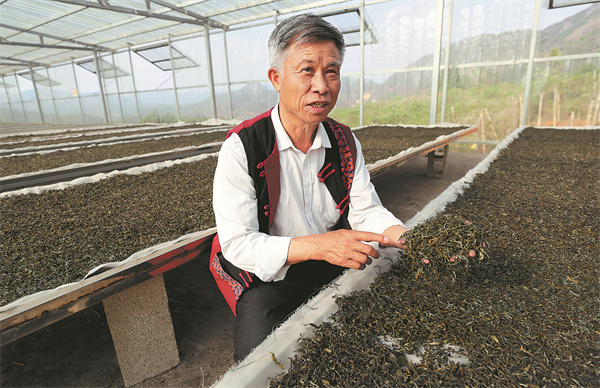May 21, 2025 | 10:07 GMT +7
May 21, 2025 | 10:07 GMT +7
Hotline: 0913.378.918
May 21, 2025 | 10:07 GMT +7
Hotline: 0913.378.918
A decade later, Li's mother, Kuang Zhiying, who taught him all about tea, finally smiled after sipping from a cup that Li had made.

Li Xingchang, an inheritor of making gongcha, or Pu'er tribute tea. Photo: Zhang Wei/China Daily
"It's been hard to do the same thing for a decade, but it has paid off," says Li, an eighth-generation inheritor of his family's Pu'er tea business.
In 2022, traditional Chinese tea-making techniques were included by the UNESCO in its representative list of intangible cultural heritage of humanity. Pu'er tea-making is one of the 44 techniques included.
Li is the first national-level inheritor of gongcha, or Pu'er "tribute tea", which was exclusively enjoyed by royal families during the Qing Dynasty (1644-1911).
"The process of stirring is key to the taste of this 'tribute tea'," Li, 70, says, adding that he has to adjust the interval time of each toss, lasting either a few seconds or even half a second, while his hands feel the change of humidity and temperature of the tea leaves.
Pu'er tea is a kind of aged and fermented tea produced in Southwest China's Yunnan province. It's named after the city where dark tea was first developed hundreds of years ago.
Making the special Pu'er tea is an elaborate process of some 70 steps, compared with other Chinese tea categories — green, yellow, black and oolong. Li says when stirring the tea buds, how high he tosses them from and what kind of wood he chooses to burn to match the suitable level of heat the tea requires are all elements that can affect the final quality.
"To be a good maker of 'tribute Pu'er', one has to have gifts apart from persistence," Li says.
He established a training center in Pu'er city where about 10,000 people have taken part in tea courses. However, no more than 10 could make him smile, he says.
"It takes one at least eight to 10 years to learn the technique. I'm not worried that my skills will be replaced by machines," says Li when asked whether he is nervous about artificial intelligence.
Li began learning the tea-making technique from Kuang when she was 80 years old. The family has passed down the craft for generations. Their craft was recognized by experts after a pumpkin-shape special Pu'er cake of tea was found at the Palace Museum, also known as the Forbidden City, inhabited by royal families in Beijing. It was about the same size, weight and shape of the tea cake usually made by her.
Kuang spent a lot of her money buying the management rights to part of an ancient tea garden, which was used for growing tea plants to make "tribute tea" for the imperial court but deserted later. Kuang wanted her children to protect the tea garden and inherit the craft.
Li was chosen as the inheritor among three offspring and spent 10 years to win Kuang's approval. She was 90 by then.
"My grandmother was very strong. If she wanted to eat mango, she would climb onto the tree to get it by herself even in her old age," says Li Mingjie, daughter of Li Xingchang. "My father's hands are also sensitive when stirring tea leaves. They are better than any machine."
Two years ago, Li Xingchang participated in a national-level skill competition that attracted tens of thousands. He won the top prize in group tea-making.
"Many are confused as to why I take part in such competitions since I've already won fame. I just want to prove that I'm still No 1 in this field although I'm not young," Li Xingchang says.
He takes cooking a dish of cabbage as an example to show the difference between tea made by different people.
"The cooking process is the same when producing the same dish with the same raw materials and seasonings. However, the taste differs depending on the chefs," he says. Elements such as the time of picking tea leaves, the humidity, sunshine, temperature, firing wood and the mindset of the maker influence the tea's flavor.
"A good tea maker should have high concentration levels," says Li Xingchang.
(Chinadaily)

(VAN) Attempts to bring down the price of the Japanese staple have had little effect amid a cost-of-living crisis.

(VAN) Fourth most important food crop in peril as Latin America and Caribbean suffer from slow-onset climate disaster.

(VAN) Shifting market dynamics and the noise around new legislation has propelled Trouw Nutrition’s research around early life nutrition in poultry. Today, it continues to be a key area of research.

(VAN) India is concerned about its food security and the livelihoods of its farmers if more US food imports are allowed.

(VAN) FAO's Director-General emphasises the need to work together to transform agrifood systems.

(VAN) Europe is facing its worst outbreak of foot-and-mouth since the start of the century.

(VAN) The central authorities, in early April, released a 10-year plan for rural vitalization.